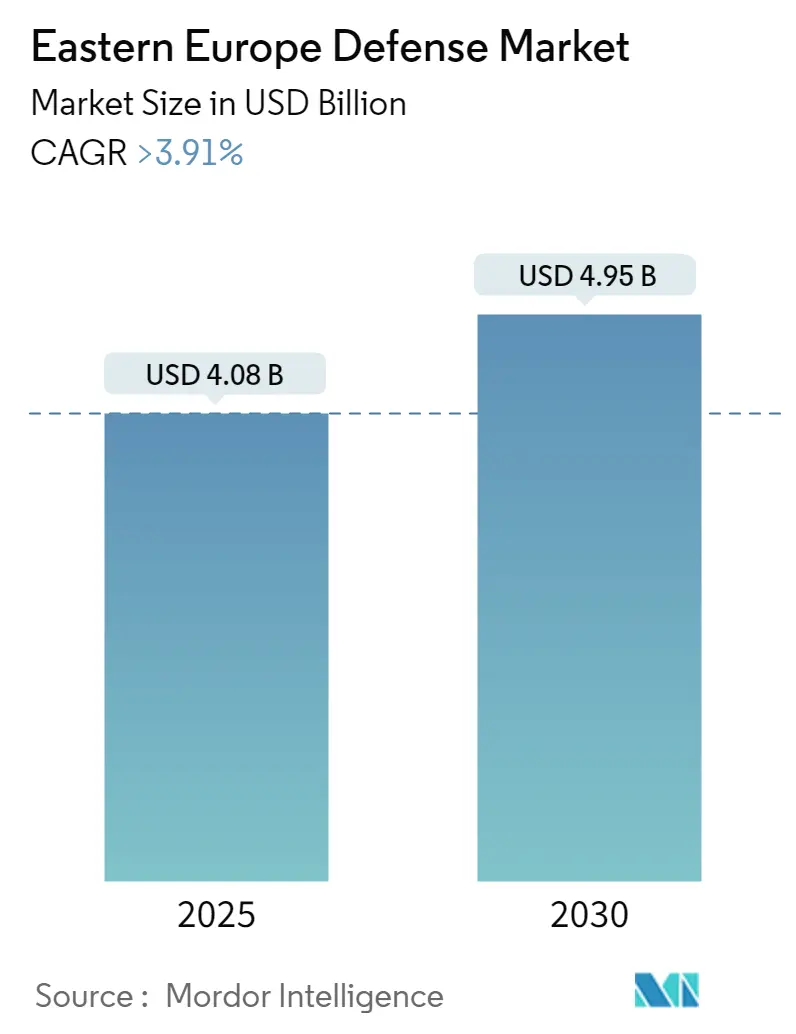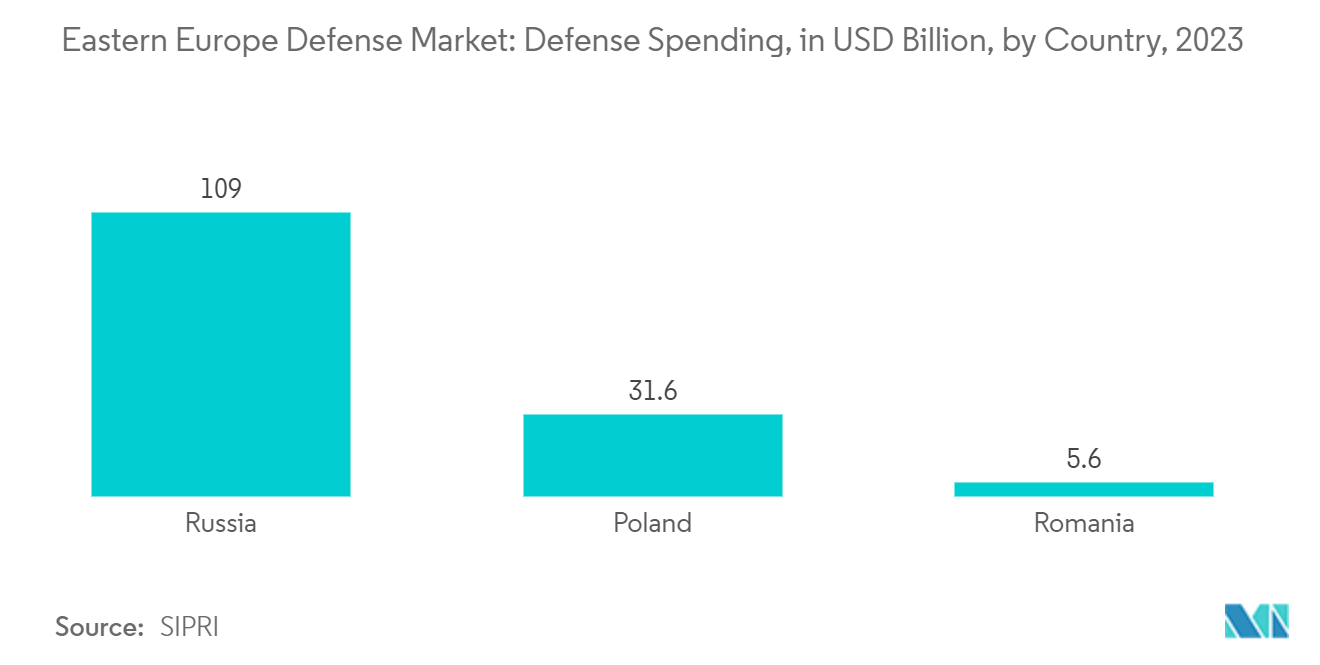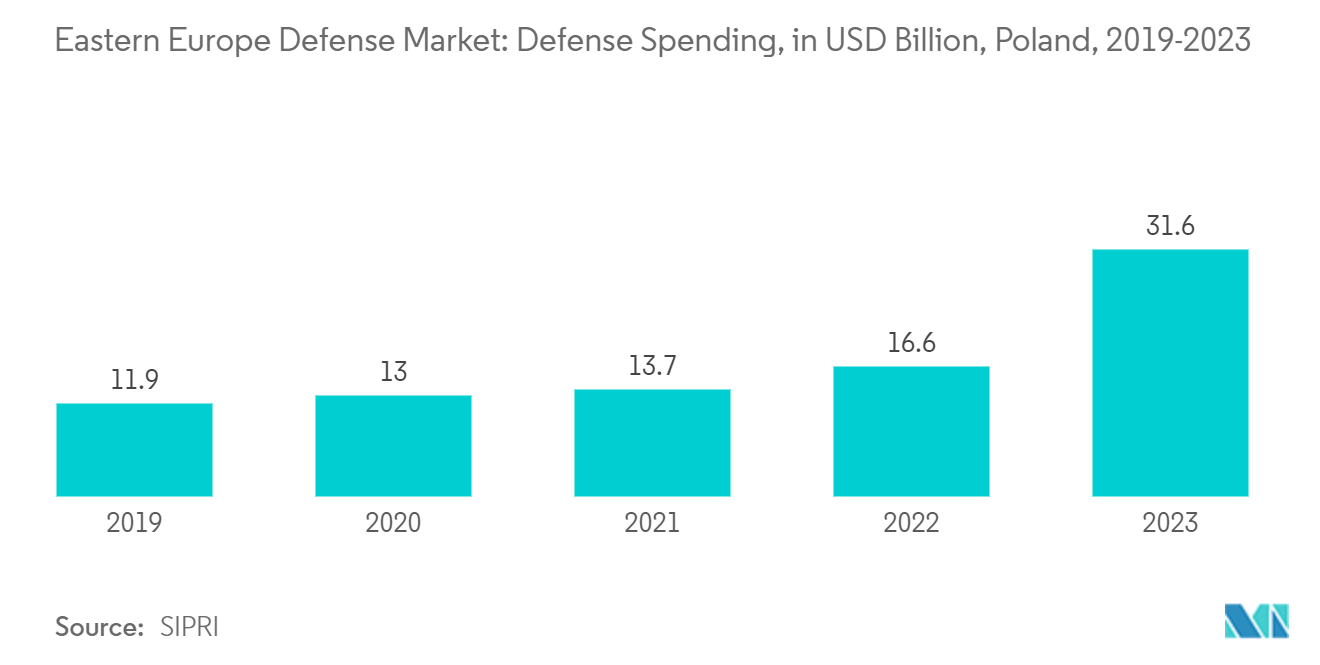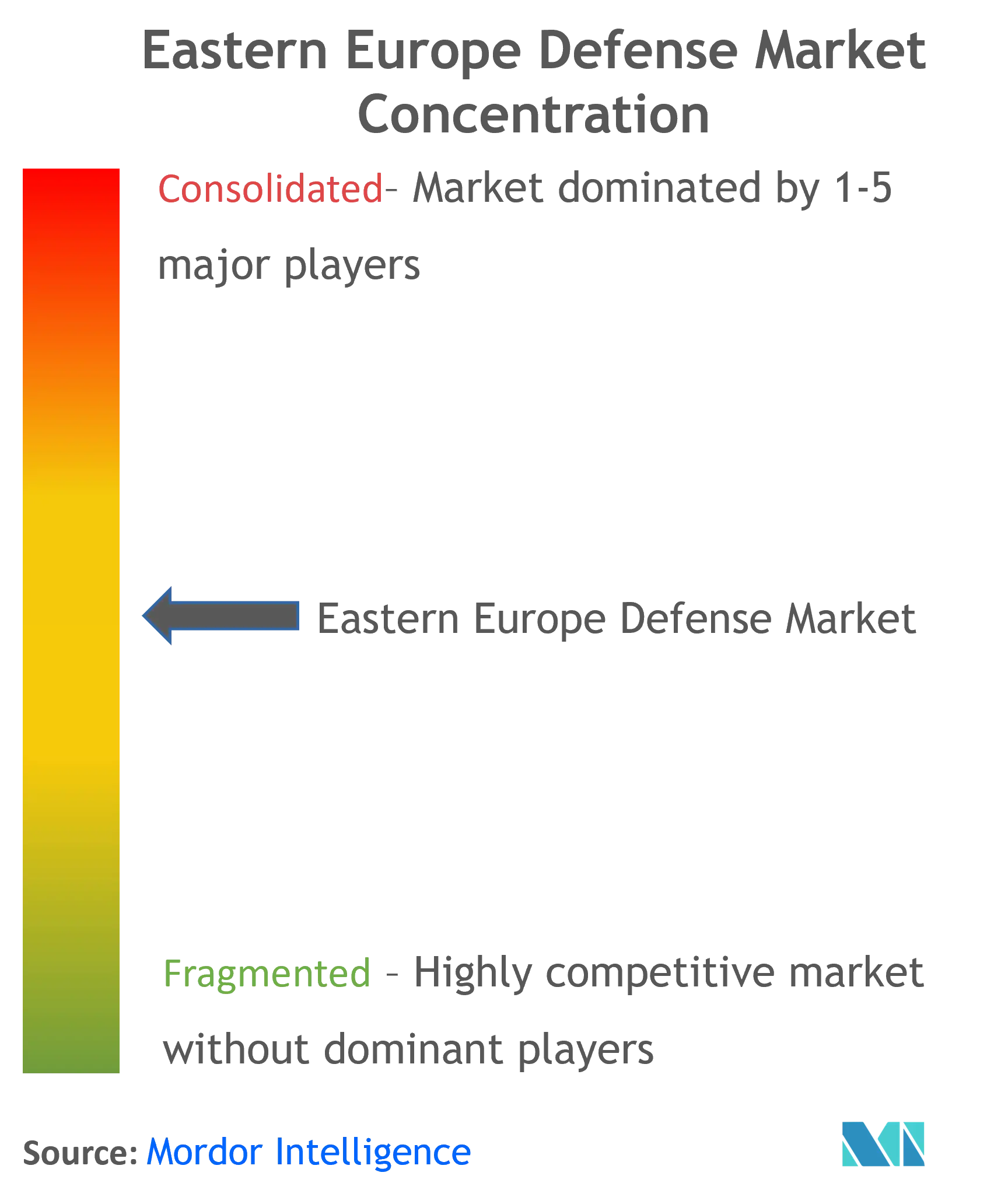
| Study Period | 2019 - 2030 |
| Base Year For Estimation | 2024 |
| Forecast Data Period | 2025 - 2030 |
| Market Size (2025) | USD 4.08 Billion |
| Market Size (2030) | USD 4.95 Billion |
| CAGR (2025 - 2030) | 3.91 % |
| Market Concentration | Medium |
Major Players
*Disclaimer: Major Players sorted in no particular order |
Eastern Europe Defense Market Analysis
The Eastern Europe Defense Market size is estimated at USD 4.08 billion in 2025, and is expected to reach USD 4.95 billion by 2030, at a CAGR of greater than 3.91% during the forecast period (2025-2030).
The military expenditure of the region continued to increase, driven by the regional conflicts and the push for modernization. According to SIPRI, the defense spending of the countries in the region totaled USD 181 billion in 2023, an increase of 31% compared to that of 2022 and 118% higher than that of 2014.
Furthermore, the Russian invasion of Ukraine, the most significant armed conflict in the region since the Second World War, is expected to propel the defense spending of the region in the years to come. Countries in the region are going through many military modernization plans, and they are planning to upgrade their armed, naval, and air forces. Such factors may drive the market in the coming years. The growing perceptions of the threat from Russia and calls from the United States to the NATO countries to increase their defense spending will be the growth drivers for the market.
The industry faces challenges due to the high costs of advanced technologies. Developing and deploying cutting-edge systems, including sophisticated sensors, EO/IR systems, and unmanned platforms, involves substantial investments. The high cost poses a barrier for some entities, hindering the adoption and creating a challenge for the industry.
Eastern Europe Defense Market Trends
Vehicles Segment to Dominate Market Share During the Forecast Period
- In 2024, the vehicles segment dominated the market, owing to the region's various ongoing upgrade and procurement programs. Currently, most of the investments are being directed toward fleet expansion initiatives. Additionally, fleet modernization plans are underway for many countries, as most of the fleet in the region belonged to the Soviet era. Many countries in the region are members of NATO and have vowed to increase their military spending to 2% of the GDP. Countries such as Poland and Russia are focusing on expanding their fleet of naval vessels, thereby propelling the segment's growth.
- In recent years, Russian authorities have been conducting trials on the new spy aircraft, dubbed the All-Seeing Eye. The aircraft is a Beriev A-100 retrofitted with 20 tons of unique surveillance equipment. The AEW&C aircraft is built on the latest version of the Ilyushin Il-76 military transport aircraft. The A-100 sports an active electronically scanned array radar (AESA) in its rotating radome. These aircraft are expected to replace the existing A50 aircraft in the Air Force fleet.
- In addition, as of January 2022, 13 nuclear-powered submarines were at different stages of construction in the Russian shipyards. They are all expected to be delivered to the Navy before 2027. The Russian Navy plans to build and procure 40 Project 12,700 mine countermeasure vessels by 2035.
- In addition to the naval capabilities, countries are developing their aerial and terrestrial capabilities for surveillance and combat missions. In April 2022, Hungary announced that it had ordered 12 modern Aero Vodochody L-39NG trainer aircraft. The first aircraft will be delivered in 2024. Such procurements are anticipated to propel

Poland to Show Significant Growth During the Forecast Period
- Poland is expected to show significant growth during the forecast period compared to other countries. Poland's military is continuously changing to transform into a more capable, modern, and NATO-compatible force. Poland's military spending was USD 31.6 billion in 2023, 75% higher than in 2022.
- Poland’s spending in 2023 was partly financed through an off-budget funding mechanism established in 2022. This fund accounted for 27% of the country’s total military expenditure in 2023. The extra funds would be allocated mainly to modernization efforts pursued by the military. Poland is already spending 2% of its GDP on defense and is planning further increases. In March 2022, the country announced plans to expand the defense spending from the NATO-recommended 2% to 4% in 2023, driven by the Russia-Ukraine war and the perceived Russian threat. The spending levels will enable the country to increase the size of its armed forces, restore the reserve system, and modernize its equipment.
- The government is making changes in every area of operation, including training, protection, communications, weapon systems, and all types of vehicles. The main elements of the Polish army's modernization plans include improving troop capacity and air defense systems and developing weaponry and manned and unmanned vehicle strength.
- In June 2023, the Polish Defense Ministry approved a large purchase of Polish-made artillery ammunition to increase the Polish industry's production capacity and support the training of Polish soldiers. Poland developed its own 35mm programmable ammunition and is expanding its applications in naval and land platforms. PIT-RADWAR’s 35mm artillery system and the programmable munitions produced by the Polish industry are being prepared for implementation in many configurations. The first version of the system, with the 35 mm gun (OSU-35), has already become a part of the ORP Kaszub Corvette’s inventory. The system will also be installed on another two Kormoran-class MCMVs.
- In April 2022, Poland signed a deal with MBDA under which the country's military will get a short-range air-defense system using MBDA's Common Anti-air Modular Missile, or CAMM. Such procurement activities for land, air, and sea platforms are expected to propel the growth of the country's market during the forecast period.

Eastern Europe Defense Industry Overview
The Eastern Europe Defense market is semi-consolidated. Rostec, BAE Systems plc, THALES, United Shipbuilding Corporation, and Rheinmetall AG are some of the major players in the market. Mergers and acquisitions are increasing as players aim to increase productivity and cut costs. For instance, in June 2022, Rostec merged United Aircraft Corporation (UAC) and the fighter manufacturers Sukhoi and Mikoyan-Gurevich into a single aircraft building center. The optimization is expected to enhance productivity and save the company about USD 1.7 billion.
Local manufacturers are strengthening their presence in the region by increasing their production capabilities and forming joint ventures with foreign players, thereby increasing their competitiveness in the market. Furthermore, players can take advantage of rising opportunities from countries like Poland, Romania, and Bulgaria, as these countries are planning further upgrades of military equipment in the coming years.
Eastern Europe Defense Market Leaders
-
Rostec
-
Rheinmetall AG
-
United Shipbuilding Corporation
-
BAE Systems plc
-
THALES
- *Disclaimer: Major Players sorted in no particular order

Eastern Europe Defense Market News
- December 2023: PGZ-Amunicja Consortium (Poland's state-owned group) and the Armament Agency signed an agreement for 300,000 155-mm artillery ammunition units as part of the National Ammunition Reserve initiative. This particular contract stood out historically due to its substantial order size and estimated worth of close to PLN 11 billion (USD 2.75 billion). The scheduled delivery of ammunition is set to occur between 2024 and 2029.
- December 2023: The Romanian Ministry of Defense entered a contract with Rheinmetall for the comprehensive modernization of the country's Oerlikon GDF 103 air defense artillery systems. Four systems are scheduled for delivery, with two to be completed within two years and the remaining two within the following three years. The agreement is valued at approximately EUR 328 million (USD 350 million) and includes provisions for training, spare parts, and additional services.
Eastern Europe Defense Industry Segmentation
Bulgaria, Hungary, the Czech Republic, Ukraine, Moldova, Belarus, Russia, Slovakia, Romania, and Poland are the countries considered in Eastern Europe per the UN Statistics Division. The report includes revenues from procurement and aftermarket services. The weapons and ammunition segment includes artillery and mortar systems, infantry weapons, missiles, missile defense systems, and small, medium, and large-caliber ammunition.
The report is segmented by type into personnel training and protection, communication systems, weapons and ammunition, and vehicles. By country, the market is segmented into Poland, Russia, Hungary, Romania, and Rest of Eastern Europe. The report also offers the market size and forecasts for four countries across the region. For each segment, the market sizing and forecasts were made based on value (USD).
| By Type | Personnel Training and Protection |
| Communication Systems | |
| Weapons and Ammunition | |
| Vehicles | |
| By Country | Poland |
| Russia | |
| Hungary | |
| Romania | |
| Rest of Eastern Europe |
Eastern Europe Defense Market Research FAQs
How big is the Eastern Europe Defense Market?
The Eastern Europe Defense Market size is expected to reach USD 4.08 billion in 2025 and grow at a CAGR of greater than 3.91% to reach USD 4.95 billion by 2030.
What is the current Eastern Europe Defense Market size?
In 2025, the Eastern Europe Defense Market size is expected to reach USD 4.08 billion.
Who are the key players in Eastern Europe Defense Market?
Rostec, Rheinmetall AG, United Shipbuilding Corporation, BAE Systems plc and THALES are the major companies operating in the Eastern Europe Defense Market.
What years does this Eastern Europe Defense Market cover, and what was the market size in 2024?
In 2024, the Eastern Europe Defense Market size was estimated at USD 3.92 billion. The report covers the Eastern Europe Defense Market historical market size for years: 2019, 2020, 2021, 2022, 2023 and 2024. The report also forecasts the Eastern Europe Defense Market size for years: 2025, 2026, 2027, 2028, 2029 and 2030.
Our Best Selling Reports
Eastern Europe Defense Industry Report
Statistics for the 2025 Eastern Europe Defense market share, size and revenue growth rate, created by Mordor Intelligence™ Industry Reports. Eastern Europe Defense analysis includes a market forecast outlook for 2025 to 2030 and historical overview. Get a sample of this industry analysis as a free report PDF download.




